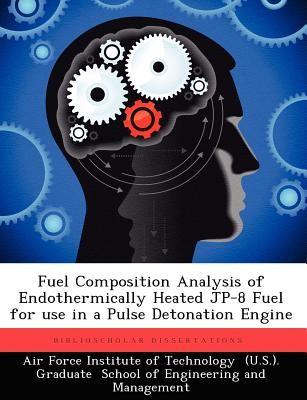
- We will send in 10–14 business days.
- Author: Eric A Nagley
- Publisher: BiblioScholar
- ISBN-10: 1249401364
- ISBN-13: 9781249401360
- Format: 18.9 x 24.6 x 0.7 cm, softcover
- Language: English
- SAVE -10% with code: EXTRA
Fuel Composition Analysis of Endothermically Heated Jp-8 Fuel for Use in a Pulse Detonation Engine (e-book) (used book) | bookbook.eu
Reviews
Description
Waste heat from a pulse detonation engine (PDE) was extracted via zeolite catalyst coated concentric tube-counter flow heat exchangers to produce supercritical pyrolytic conditions for JP-8 fuel. A sampling system and method were developed that enabled samples of reacted fuel to be extracted during steady state operation. Samples were taken over a range of heat exchanger exit temperatures from 820 K (1016 oF) to 940 K (1232 oF). Offline analysis of liquid and vapor fuel samples indicated fuel decomposition via typical pyrolytic reaction pathways. The liquid analysis showed conversion of parent fuel components with formation of unsaturates (aromatics and alkenes) and smaller alkanes. The gaseous products consisted of predominantly C1-C3 alkanes and alkenes (gt; 75% of total vapor yield) with moderate amounts of hydrogen and C4-C6 alkanes and alkenes. The components that were present in the stressed fuel samples were more detonable and could be linked to improved PDE performance. The ignition time decreased by over 20% as temperature increased from 820 K (1016 oF) to 935 K (1224 oF) and by more than 30% when compared to unreacted (flash vaporized) JP-8.
EXTRA 10 % discount with code: EXTRA
The promotion ends in 13d.23:17:53
The discount code is valid when purchasing from 10 €. Discounts do not stack.
- Author: Eric A Nagley
- Publisher: BiblioScholar
- ISBN-10: 1249401364
- ISBN-13: 9781249401360
- Format: 18.9 x 24.6 x 0.7 cm, softcover
- Language: English English
Waste heat from a pulse detonation engine (PDE) was extracted via zeolite catalyst coated concentric tube-counter flow heat exchangers to produce supercritical pyrolytic conditions for JP-8 fuel. A sampling system and method were developed that enabled samples of reacted fuel to be extracted during steady state operation. Samples were taken over a range of heat exchanger exit temperatures from 820 K (1016 oF) to 940 K (1232 oF). Offline analysis of liquid and vapor fuel samples indicated fuel decomposition via typical pyrolytic reaction pathways. The liquid analysis showed conversion of parent fuel components with formation of unsaturates (aromatics and alkenes) and smaller alkanes. The gaseous products consisted of predominantly C1-C3 alkanes and alkenes (gt; 75% of total vapor yield) with moderate amounts of hydrogen and C4-C6 alkanes and alkenes. The components that were present in the stressed fuel samples were more detonable and could be linked to improved PDE performance. The ignition time decreased by over 20% as temperature increased from 820 K (1016 oF) to 935 K (1224 oF) and by more than 30% when compared to unreacted (flash vaporized) JP-8.


Reviews